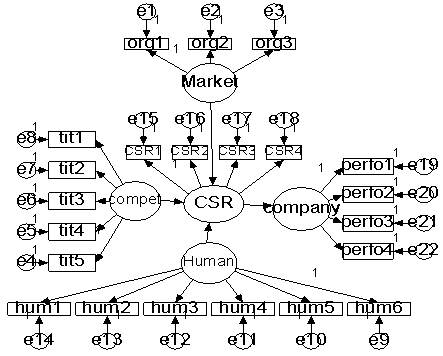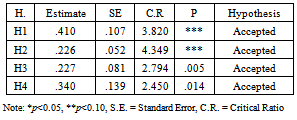-
Paper Information
- Next Paper
- Previous Paper
- Paper Submission
-
Journal Information
- About This Journal
- Editorial Board
- Current Issue
- Archive
- Author Guidelines
- Contact Us
American Journal of Economics
p-ISSN: 2166-4951 e-ISSN: 2166-496X
2013; 3(C): 29-34
doi:10.5923/c.economics.201301.06
Corporate Social Responsibility: Antecedent and Consequence Study of Malaysian Public Listed Companies
Abdul Rahim Othman, Selvan Perumal, Saed Adnan Mstafa
College of Business, University Utara Malaysia, Kedah, 06010, Malaysia
Correspondence to: Saed Adnan Mstafa, College of Business, University Utara Malaysia, Kedah, 06010, Malaysia.
| Email: |  |
Copyright © 2012 Scientific & Academic Publishing. All Rights Reserved.
This paper examines the antecedent and the consequence variables of corporate social responsibility. 200 responses were received from a population that had already working in Malaysian public listed companies. The results derived from multi-group structural equation modeling within AMOS 7.0 revealed that the antecedent variables drive CSR to success in Malaysian public listed companies, furthermore this paper found a significant relationship between CSR and company performance. The findings imply the need for public listed companies, particularly main and ACE board, to strategically leverage the key antecedents of CSR. This could enhance its sustainability, competitiveness and innovation following market trends.
Keywords: CSR, Company Performance, Structural Equation Modeling
Cite this paper: Abdul Rahim Othman, Selvan Perumal, Saed Adnan Mstafa, Corporate Social Responsibility: Antecedent and Consequence Study of Malaysian Public Listed Companies, American Journal of Economics, Vol. 3 No. C, 2013, pp. 29-34. doi: 10.5923/c.economics.201301.06.
Article Outline
1. Introduction
- The focus on CSR has increased in recent years in the world; the general trend towards CSR projects is still shadowy in Malaysia[1-4]. Despite all Malaysian government effort to encourage adopting CSR, only few companies had taken it seriously[5]. Another study conducted by[6] reported that the Malaysian companies are yet to meet the international standards, especially in the area of CSR project implementation. CSR is very important to improve the performance of companies as suggested by[7-8]. Recently the government paid great attention to CSR to be adopted by public listed (PLCs) and private companies in Malaysia[7]. Despite this finding, unfortunately in Malaysia this area has not been widely covered yet[9]. Previous studies tended to study the relationship between CSR and company performance. The results of the studies found different impact between CSR and company performance. The findings of CSR with company performance seem inconclusive, as found by studies of [10-15] that there is a positive relationship between CSR and company performance. In other studies by[16-21] whilst there is evidence that CSR relates to company performance, several studies reported no significant association between CSR and company performance. The review of literature also shows that none of the studies that examined the effect of CSR in company performance especially in Public companies sector were conducted in Malaysia.
2. Literature Review
2.1. Market Orientation and CSR
- Previous researches confirm that market orientation is the process of value creation by identifying the needs and expectations of the customers[22]. Customer satisfaction is the key aspect in the marketing concept and no or minimal was attention paid on social welfare in marketing concept[23-24]. Pure customer orientation can give only a short term profit and it will fail to generate a long term profit[25].[24] Has proven that customers expect their marketers to contribute to social activities. As such customers in the banking sector in particular expect banks to be socially responsible[26]. Thus customers expect their marketers to be socially responsible. Furthermore, study by[27] hypothesized that market orientation positively affect CSR, they found in their study there market orientation drive CSR. H1: There is a positive relationship between Market Orientation and corporate social responsibility.
2.2. Humanistic Orientation and CSR
- Humanistic orientation refers to the dimension of an organization’s culture that is concerned with the importance attributed to collaboration and harmony among workers [23].[28] Explained that, in humanistic culture, “employees are expected to be supportive, helpful and interested in the suggestions and ideas of others”. In such organizations, members show concern for the needs of others, give rewards to others, and involve others in the decisions affecting them[28]. In humanistic culture, values and policies promoting caring and harmony are likely to apply not only to employees but also to other stakeholder groups. One may expect that humanistic value encourage organizational members to systematically enhance the relationships between the business and its stakeholder groups by addressing their demands in the economic, legal, ethic and philanthropic responsibilities consequently[23].H2: There is a positive relationship between Humanistic Orientation and corporate social responsibility.
2.3. Competitive Orientation and CSR
- While a humanistic orientation fosters the maintenance of harmonious relationships within the organization, a competitive orientation is characterized by an emphasis on winning and personal success in the workplace[28]. The characteristics of the humanistic culture as sensitive and responsive to CSR and that the mechanism of cultural transmission ensures that the intrinsic features of this approach are transferable and guide organizations in their interactions with stakeholders[29-31]. The expectation may be put on humanistic value to encourage organizational members to enhance the relationship between stakeholder groups and the business systematically by addressing their demands in philanthropic, legal, economic and ethic responsibilities[23]. Humanistic orientation impact positively on CSR[32]. H3: There is a positive relationship between Competitive Orientation and corporate social responsibility.
2.4. CSR and Company Performance
- The relationship between corporate social responsibility and organization performance turned out to be inconclusive, calling for an extensive research work to be conducted in this area[13, 33-35]. While some studies empirically support the existence of direct as well as indirect relationships between CSR practices and company performance[10-15, 33], other studies[16-21, 36] questioned the CSR strategy effectiveness.H4: There is a positive relationship between corporate social responsibility and company performance.
3. Methodology
- Questionnaires were distributed to 225 respondents (i.e., top management), and 200 responses were received, a response rate of 89%. The respondents were collected from a population that had already experienced on CSR in Malaysian public listed companies.The questionnaire comprises four sections: Section A was designed to extract the respondents’ demographic characteristics, and Section B measured CSR based on[37-39]. Section C was designed to ask respondents to rate their company performance[40-41]. Section D to measured the antecedent variables as follow market orientation, humanistic orientation and competitive orientation[22, 28]. All instruments were designed on a five-point Likert scale ranging from ‘strongly agree - (5)’ to ‘strongly disagree - (1)’, using multi-item scales. Structural equation modeling analysis using AMOS 7.0 was conducted because it has the ability to estimate both direct and is a testable model; it also has the ability to ensure the consistency of the model with the data and to estimate the effects among the constructs. The method of estimation used was the maximum likelihood method.
4. Data Analysis
- The detailed demographic attributes of the respondents are shown in Table 1. Out of 200 respondents, 72% were male and 28% were female. More than half of the respondents 53% were Malay. Around 35.5% from the respondents were expert. The distribution of the respondents by age, with 44.5% were more than 35 years old, from 31 to 35 were 44%, 25 to 30 years 10%, and less than 25 years1.5%. These data imply that the study sample was well representative of the target top management who has working in Malaysian public listed companies.
|
4.1. Confirmatory Factor Analysis
- Confirmatory factor analysis was also used to determine if the data included in each of the four components of organization culture factors, CSR and company performance models is a strong fit. Thus, confirmatory factor analysis of CSR (twenty eight items), after having done the confirmatory factor analysis the results showed that (ECO1, ECO6, ECO7, LEG4, LEG5, LEG7, ETH1, ETH2, ETH3, ETH7, PHI5, PHI6 and PHI7) were deleted, while the other remaining items (ECO2, ECO3, ECO4, ECO5, LEG1, LEG2, LEG3 and LEG6, ETH4, ETH5, ETH6, PHI1, PHI2, PHI3 and PHI4) were analyzed and showed that all the items have a factor loading of more than .50. This suggests that the items correlated significantly to the factor itself with factor loadings ranging more than .50[42].Furthermore, Market orientation has seventeen Items; the result of CFA reveals that nine items (CUS1, CUS2, CUS5, COM1, COM2, COM4, COOR1, COOR2, and COOR6) were deleted, while the other remaining items (CUS3, CU4, COM3, COM5, COM6, COOR3, COOR4 and COOR 5) were analyzed and showed that all the items have a factor loading of more than .50. Competitive orientation has ten items, humanistic orientation has ten items, the result of CFA reveals that five items (TIT6, TIT7, TIT8, TIT9 and TIT10) were deleted, while the other remaining items (TIT1, TIT2, TIT3, TIT4, TIT5) were analyzed and showed that all the items have a factor loading of more than .50. Humanistic orientation has ten items; the result of CFA reveals that four items (HUM7, HUM8, HUM9 and HUM10) were deleted, while the other remaining items (HUM1, HUM2, HUM3, HUM4, HUM5 and HUM6) were analyzed and showed that all the items have a factor loading of more than .50[42].In this respect, company performance has six items; the results of the confirmatory factor analysis reveals that two items (PERFO5 and PERFOR6) were deleted after having conducted the confirmatory factor analysis. The remaining four items (PERFO1, PERFO2, PERFO3 and PERFO4) indicated a factor loading of more than .50. This proposed that the three items correlated significantly to the factor itself with factor loadings ranging more than .50[42]. As Shown in Table 2.The fit of measurement of hypotheses model, is good as indicated by GFI, TLI, CFI, GFI, TLI, and CFI values are higher than the threshold values suggested by[43]. In addition, the most widely used CMIN/DF measure, also suggests a very good fit.
|
 | Figure 1. The Structural Model |
4.2. Hypothesis Testing
- A direct effect represents the effect of an independent variable on a dependent variable. From Figure 1 and Table 3, it shows that the hypotheses test, in determining the significance of each path coefficient, estimate of regression weight, standard error of regression weight, and critical ratio for regression weight, (C.R= dividing the regression weight estimate by the estimate of its standard error gives) were used.Table 3 presents each parameter's C.R., estimate and S.E of the generating model. Hence, market orientation has a significant positive and direct impact on CSR (β =.410, C.R = 3.280; P = ***) or H1 is supported. Competitive orientation has a significant positive and direct impact on CSR (β=.226, C.R= 4.349; P= ***) or H2 is supported. Humanistic orientation has a positive significant direct impact on CSR (β=.227, C.R= 2.794; P= 0.005) or H3 is also supported. However, perceived CSR has a positive direct impact on company performance (β= 0.340, C.R= 2.450, P= 0.014) or H4 is supported.
|
5. Further Research
- This study only focused on public listed companies in Malaysia. Other companies, such as small and medium size, and private companies, were excluded from the study. There is now an opportunity to research CSR in this broader sector. In particular, it would be interesting to undertake research on the small and medium size given the increased level of competition.[34] Conducted a study to discover the relationship between CSR and company performance by determining the presence of CSR features on public listed companies. They found that companies differ in the presence of CSR features, and that there is a positive relationship between CSR and company performance.Many companies believe that they will be successful if they invest more money by adopting CSR[9, 49]. The impact of CSR on company performance is real and so are the problems for certain organizations in terms of successful implementation[16, 20]. Finally, future research could examine more antecedent or factors influencing CSR in Malaysia, since the variables are still recommended to be investigated on a larger scale by future research with specific attention being given to CSR. These variables could include the Public Concern, Regulatory Forces and others.
 Abstract
Abstract Reference
Reference Full-Text PDF
Full-Text PDF Full-text HTML
Full-text HTML

